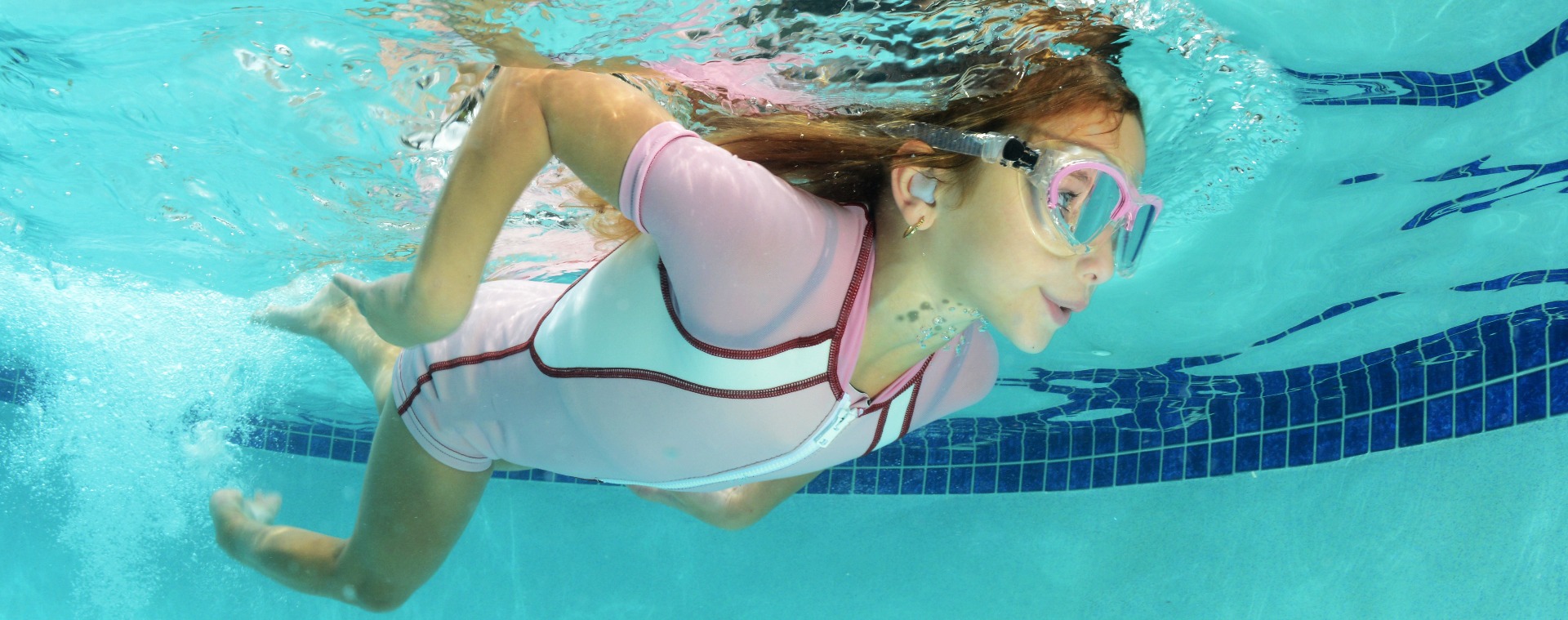EAR PLUGS FOR THE POOL: WHY AND HOW TO CHOOSE THEM

31 May 2019
Updated on June 09 2023
Protecting our hearing and maintaining a healthy balance system are essential, especially in aquatic environments where our ears may be more susceptible to water-borne infections. One such condition that occasional and professional swimmers may encounter is otitis, a common ear infection caused by water entering the ear canal. Fortunately, ear plugs specifically designed for swimming offer an effective solution, reducing the risk of water infiltrating the ear canal.
What is a Swimming Ear plug?
There are many types of earplugs, each serving a specific purpose. For instance, some are designed to dampen ambient noise, like those used in noisy work environments or during sleep. However, custom-made swimming earplugs work differently. Rather than blocking noise, they act as protective barriers against water infiltration while allowing sound to pass through, thus ensuring swimmers can effectively hear.
Materials such as silicone, acrylic, or wax are commonly used in the manufacturing of these earplugs due to their malleability and water-resistant properties. This design makes them adaptable to various shapes and sizes of the ear canal, ensuring a comfortable fit and ease of use.
When should you use swimming ear plugs?
The properties of ear plugs for the pool – that is, impermeability and resistance – make these ideal accessories to use in all sorts of conditions in an aquatic environment. Indeed, while they can be used in
The inherent properties of these ear plugs – waterproofness and durability – make them ideal for various conditions within a water environment. Beyond regular swimming sessions, these plugs can also be used during extreme water sports, providing protection against water entering the ear canal.
Moreover, under unfavorable weather conditions such as sandstorms or strong winds, ear plugs can offer additional protection to the ear canal. However, it is crucial to note that these plugs are not suitable for scuba diving due to the risk of eardrum rupture under water pressure, which can potentially cause serious injuries
How to Choose the Right Swimming Earplugs?
Getting an accurate impression of your ear and auditory canal at an audiology clinic is the first step in custom-making your earplugs. While this may seem like an additional initial expense, these custom earplugs are more durable, making them a cost-effective long-term investment.
When selecting the right custom swimming earplugs, the following elements should be taken into consideration:
Ease of Cleaning: Earplugs require minimal maintenance. A simple rinse with clean water after each use is generally enough to ensure their durability and continued effectiveness.
Good Fit: An earplug that stays in place while swimming is essential. Earplugs are designed to fit all ear shapes, ensuring they stay put even during physical activity.
Comfort: Swimming earplugs are designed to be comfortable to wear for the duration of your swim without causing discomfort. Their malleable nature allows for quick and easy insertion into the auditory canal.
Discretion: Compared to other forms of ear protection like headbands, swimming earplugs are more discreet. They blend into the wearer’s ears and do not hinder communication or normal hearing, while providing protection against unwanted noise up to approximately 24 decibels.
The Risks of Not Using Ear Plugs
Not using ear plugs while swimming may seem harmless, but it can pose several health risks. Swimmer’s ear (also known as external otitis) is an infection that occurs when water gets trapped in the ear, creating a damp environment conducive to bacterial growth. Symptoms can include ear pain, redness, swelling, and sometimes even pus discharge.
Furthermore, regular exposure to water can soften the skin of the ear canal, which can lead to pruritus, a condition characterized by intense itching and potential inflammation. In rare cases, prolonged exposure to water without adequate ear protection can even result in a more serious infection called malignant external otitis. This is a severe infection that can affect the underlying bone and cartilage of the ear and can be fatal if not properly treated.
Cleaning and Maintenance of Earplugs
While a simple rinse with clean water is a basic step for cleaning your swimming earplugs, a more comprehensive cleaning regimen can extend their lifespan and maintain their effectiveness.
After each use, thoroughly rinse your earplugs under warm running water to remove any debris. Then, use a mild soap or a specially formulated cleaning solution to remove any buildup of wax or bacteria. Make sure to rinse the earplugs thoroughly after cleaning to eliminate any soap residue. Afterward, allow the earplugs to air dry completely before storing them in a clean, dry protective case.
Comparison of Earplug Materials
Swim earplug material can dramatically affect your experience. Silicone, acrylic, and wax dominate the market. Each material has advantages and downsides.
Silicone: Swimmers and water sports people may prefer silicone. Silicone earplugs can withstand heavy use and are durable and water-resistant. They’re also moldable, so they suit your ear properly and protect it. If you swim fast, silicone earplugs may fall out.
Acrylic: Acrylic ear plugs provide sound. They’re durable, water-resistant, and customizable. While effective, they may be less pleasant than silicone or wax. If comfort is a priority, consider other solutions.
Wax: Wax earplugs are better for comfort. The wax in these earplugs molds to your ear, making them the most comfortable. Wax degrades faster than silicone or acrylic. Earplugs would need to be replaced more often.
Your priorities determine what’s important. Silicone and acrylic are durable materials. However, wax may be the best material for comfort.
Why should you buy custom made ear plugs for the pool ?
Custom earplugs may seem like a luxury, but they can make a big difference to your comfort and efficiency. Custom earplugs offer a more precise fit, ensuring better protection against water and greater comfort during use.
Comparison with Other Types of Ear Protection
Swim caps, ear bands, and earplugs are all forms of swimming ear protection. Swim caps prevent water from entering the ears, although they’re not waterproof. However, ear bands protect the external ear from water.
These choices may provide additional protection, but they do not totally block water and may not be enough for people prone to ear infections. For best protection, they are commonly used alongside earplugs.
To conclude, our auditory system is vital, especially in water. Swimming earplugs protect our ears as we enjoy aquatic sports. Custom-made earplugs provide optimal protection and durability.
References:
- Harris, P., & Bartlett, J. (2016). Auditory health in professional swimmers: a review. Journal of Sports Sciences, 34(3), 214-220.
- Oghalai, J. (2013). Swim molds: prevention of swimmer’s ear. Otology & Neurotology, 34(1), 19-20.
- Sataloff, J., & Hawkshaw, M. (2011). The Complete Guide to Ear Care and Hearing Loss Prevention. Thieme.
- Waseem, M., & Rosenberg, H. (2016). Otitis Externa, Swimmer’s Ear. National Center for Emergency Medicine Informatics.
- Stafford, R. (2013). Diver’s Ear – Infections and Barotrauma. Journal of Diving Medicine, 18(1), 12-18.
Autres articles
HOW TO INTEGRATE CONNECTED HEARING AIDS INTO YOUR DAILY LIFE
To provide the best possible service to improve the daily lives of hearing-impaired people, connected hearing aids and their complementary…
THE DIFFERENT TYPES OF ALMOST INVISIBLE HEARING AIDS
Several types of nearly invisible hearing aids are now available in different shapes and colours to suit the hearing needs…
SYMPTOMS OF A RUPTURED EARDRUM AND MOVEMENTS TO ADOPT
A ruptured eardrum is very common and may occur for many reasons. How do you recognize it and what should…


